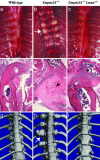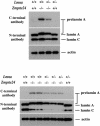Heterozygosity for Lmna deficiency eliminates the progeria-like phenotypes in Zmpste24-deficient mice
- PMID: 15608054
- PMCID: PMC536056
- DOI: 10.1073/pnas.0408558102
Heterozygosity for Lmna deficiency eliminates the progeria-like phenotypes in Zmpste24-deficient mice
Abstract
Zmpste24 is a metalloproteinase required for the processing of prelamin A to lamin A, a structural component of the nuclear lamina. Zmpste24 deficiency results in the accumulation of prelamin A within cells, a complete loss of mature lamin A, and misshapen nuclear envelopes. Zmpste24-deficient (Zmpste24(-/-)) mice exhibit retarded growth, alopecia, micrognathia, dental abnormalities, osteolytic lesions in bones, and osteoporosis, which are phenotypes shared with Hutchinson-Gilford progeria syndrome, a human disease caused by the synthesis of a mutant prelamin A that cannot undergo processing to lamin A. Zmpste24(-/-) mice also develop muscle weakness. We hypothesized that prelamin A might be toxic and that its accumulation in Zmpste24(-/-) mice is responsible for all of the disease phenotypes. We further hypothesized that Zmpste24(-/-) mice with half-normal levels of prelamin A (Zmpste24(-/-) mice with one Lmna knockout allele) would be subjected to less toxicity and be protected from disease. Thus, we bred and analyzed Zmpste24(-/-)Lmna(+/-) mice. As expected, prelamin A levels in Zmpste24(-/-)Lmna(+/-) cells were significantly reduced. Zmpste24(-/-)Lmna(+/-) mice were entirely normal, lacking all disease phenotypes, and misshapen nuclei were less frequent in Zmpste24(-/-)Lmna(+/-) cells than in Zmpste24(-/-) cells. These data suggest that prelamin A is toxic and that reducing its levels by as little as 50% provides striking protection from disease.
Figures





References
-
- Pendás, A. M., Zhou, Z., Cadiñanos, J., Freije, J. M. P., Wang, J., Hultenby, K., Astudillo, A., Wernerson, A., Rodríguez, F., Tryggvason, K. & Lopéz-Otín, C. (2002) Nat. Genet. 31, 94–99. - PubMed
Publication types
MeSH terms
Substances
Grants and funding
LinkOut - more resources
Full Text Sources
Other Literature Sources
Molecular Biology Databases
Research Materials
Miscellaneous

